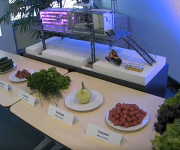Plant cultivation training
Although I only leave in December 2017 to my one year long expedition in Antarctica, preparations are already going on now. I will be responsible for the operation of the EDEN ISS greenhouse in the Antarctic, and that includes all tasks from sowing to harvest the plants. My gardening skills will determine whether the greenhouse can contribute to the vegetable diet of the crew of the Neumayer III research station and whether all our experiments succeed.
I spent the last week in the Netherlands to get a crash course in plant cultivation. There I met with experienced horticulture scientists and experts. For me as a trained engineer who never really had a green thumb, the journey was fascinating and very instructive.
My journey started on Sunday night with a three and a half hour drive to the university town of Wageningen. There, Europe’s leading research facility in the areas of food, food production and plant cultivation is located. Scientists from Wageningen are also involved in EDEN ISS and are looking into the selection of suitable plants and the appropriate environmental conditions.
Monday morning, after the usual formalities such as the issue of a key card, without which I would not even get through the next door, we went past dozens of rooms packed with climate cells. A climate cell is a kind of giant cabinet with fully automatic air conditioning. Scientists use these chambers for plant experiments, because they can control all environmental conditions of the plants independent from the weather outside.
In two such chambers, Esther Meinen cultivates just exactly those plants that are considered for my expedition to Antarctica. These include many varieties of lettuce, spinach, herbs, as well as cucumbers, tomatoes, peppers and my favorite, strawberries. The whole Monday and also all day Tuesday Esther and I were busy harvesting some of the seven-week old plants. That meant each head of lettuce and cucumber, had to be accurately measured and weighed. For the herbs such as basil, but also spinach I also had to count the leaves. Every now and then I could take a small sample for try the taste.
On Wednesday I went with Tom Dueck to an extension of the University. In Bleiswijk are the really big glass greenhouses. Here scientists optimize the commercial cultivation of vegetables and are examining the effects of pests and diseases on plants. There are special closed quarantine areas with strict hygiene regulations.
The morning I spent with Jan Janse, an expert on vegetables and in particular for tomatoes, cucumbers and peppers. Inside the various greenhouses, Jan explained the differences in the cultivation of vegetables and also how I have to prune the plants to help them grow as we want them to do. In the afternoon I Marieke van der Staaij gave me an introduction to the early detection of pests and plant diseases. For this purpose we went in small isolated greenhouses where plants are deliberately contaminated with various flies, spiders and small grasshoppers to observe the effects. For me as an engineer quite new territory – there was plenty of insects to touch and observe.
On Thursday my exciting time in Wageningen was already over. The days in the climate cells and greenhouses passed by very fast and I will now try out what I have learned in our own laboratory. In August, I will return to the Netherlands for another week of training – to pierce patient local colleagues with my countless questions.











